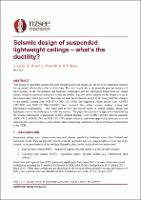| dc.contributor.author | Long, Jasin | |
| dc.contributor.author | Baird, Andrew | |
| dc.contributor.author | Pourali, Aty | |
| dc.contributor.author | Kam, Weng Yuen | |
| dc.date.accessioned | 2023-08-28T04:23:28Z | |
| dc.date.available | 2023-08-28T04:23:28Z | |
| dc.date.issued | 2023-04-19 | |
| dc.identifier.uri | https://repo.nzsee.org.nz/xmlui/handle/nzsee/2588 | |
| dc.description.abstract | In the last few years, the design of suspended ceilings has gone through significant change and the level of compliance required has increased substantially. This was largely due to the generally poor performance of these systems in the Christchurch and Kaikōura earthquakes and the subsequent requirement for ceiling seismic design by territorial authorities around the country. It is now more common for the design to occur at the consent stage where previously there may not have been a seismic design at all. Along with this, changes to the seismic loading code, NZS1170.5:2004 A1 (2016), the suspended ceiling design code, AS/NZS 2785:2020 and NZS3101:2006-A3(2017) have increased the ceiling seismic loading, testing and performance requirements. This paper first reviews the current status of ceiling seismic design and highlights some of the challenges faced by the industry. The paper then presents an approach in harmonising the seismic performance requirements in New Zealand Building Code (NZBC) and the relevant standards (NZS1170.5, AS/NZS 2785 and NZS3101). We believe a holistic risk-based approach is necessary to avoid impracticably onerous ceiling seismic design while maintaining compliance to the performance requirements of the NZBC. | |
| dc.language.iso | en | |
| dc.publisher | New Zealand Society for Earthquake Engineering | |
| dc.relation.ispartofseries | 2023;143 | |
| dc.subject | Advancements in research and practice in seismic performance | |
| dc.title | Seismic design of suspended lightweight ceilings – what’s the ductility? | |
| dc.type | Article | |

